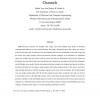Free Online Productivity Tools
i2Speak
i2Symbol
i2OCR
iTex2Img
iWeb2Print
iWeb2Shot
i2Type
iPdf2Split
iPdf2Merge
i2Bopomofo
i2Arabic
i2Style
i2Image
i2PDF
iLatex2Rtf
Sci2ools
CORR
2008
Springer
2008
Springer
To Code or Not To Code in Multi-Hop Relay Channels
Multi-hop relay channels use multiple relay stages, each with multiple relay nodes, to facilitate communication between a source and destination. Previously, distributed space-time coding was used to maximize diversity gain. Assuming a low-rate feedback link from the destination to each relay stage and the source, this paper proposes end-to-end antenna selection strategies as an alternative to distributed space-time coding. One-way (where only the source has data for destination) and two-way (where the destination also has data for the source) multi-hop relay channels are considered with both the full-duplex and half duplex relay nodes. End-to-end antenna selection strategies are designed and proven to achieve maximum diversity gain by using a single antenna path (using single antenna of the source, each relay stage and the destination) with the maximum signal-to-noise ratio at the destination. For the half-duplex case, two single antenna paths with the two best signal-to-noise ratios...
CORR 2008 | Diversity Gain | Education | Relay | Relay Stage |
| Added | 25 Dec 2010 |
| Updated | 25 Dec 2010 |
| Type | Journal |
| Year | 2008 |
| Where | CORR |
| Authors | Rahul Vaze, Robert W. Heath Jr. |
Comments (0)

